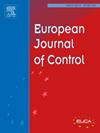基于神经动力学模型的强化学习 MPC
IF 2.5
3区 计算机科学
Q2 AUTOMATION & CONTROL SYSTEMS
引用次数: 0
摘要
本文提出了一种开发非线性模型预测控制(NMPC)策略的端到端学习方法,该方法不需要明确的第一原理模型,并假定系统动态是未知或部分已知的。本文建议利用现有的测量数据来确定一个名义递归神经网络 (RNN) 模型,以捕捉非线性动态,其中包括状态变量和输入的约束条件。为了解决简单地根据数据拟合模型所产生的次优控制策略问题,本文使用强化学习(RL)来调整 NMPC 方案,并为实际系统生成最优策略。这种方法的新颖之处在于利用 RL 克服了名义 RNN 模型的局限性,并生成了更精确的控制策略。论文讨论了 RNN 模型的初始状态估计和 MPC 中神经模型集成的实施问题。本文提出的方法在一个经典的基准控制问题上进行了演示:级联双油箱系统 (CTS)。本文章由计算机程序翻译,如有差异,请以英文原文为准。
Reinforcement learning based MPC with neural dynamical models
This paper presents an end-to-end learning approach to developing a Nonlinear Model Predictive Control (NMPC) policy, which does not require an explicit first-principles model and assumes that the system dynamics are either unknown or partially known. The paper proposes the use of available measurements to identify a nominal Recurrent Neural Network (RNN) model to capture the nonlinear dynamics, which includes constraints on the state variables and inputs. To address the issue of suboptimal control policies resulting from simply fitting the model to the data, this paper uses Reinforcement learning (RL) to tune the NMPC scheme and generate an optimal policy for the real system. The approach’s novelty lies in the use of RL to overcome the limitations of the nominal RNN model and generate a more accurate control policy. The paper discusses the implementation aspects of initial state estimation for RNN models and integration of neural models in MPC. The presented method is demonstrated on a classic benchmark control problem: cascaded two tank system (CTS).
求助全文
通过发布文献求助,成功后即可免费获取论文全文。
去求助
来源期刊

European Journal of Control
工程技术-自动化与控制系统
CiteScore
5.80
自引率
5.90%
发文量
131
审稿时长
1 months
期刊介绍:
The European Control Association (EUCA) has among its objectives to promote the development of the discipline. Apart from the European Control Conferences, the European Journal of Control is the Association''s main channel for the dissemination of important contributions in the field.
The aim of the Journal is to publish high quality papers on the theory and practice of control and systems engineering.
The scope of the Journal will be wide and cover all aspects of the discipline including methodologies, techniques and applications.
Research in control and systems engineering is necessary to develop new concepts and tools which enhance our understanding and improve our ability to design and implement high performance control systems. Submitted papers should stress the practical motivations and relevance of their results.
The design and implementation of a successful control system requires the use of a range of techniques:
Modelling
Robustness Analysis
Identification
Optimization
Control Law Design
Numerical analysis
Fault Detection, and so on.
 求助内容:
求助内容: 应助结果提醒方式:
应助结果提醒方式:


